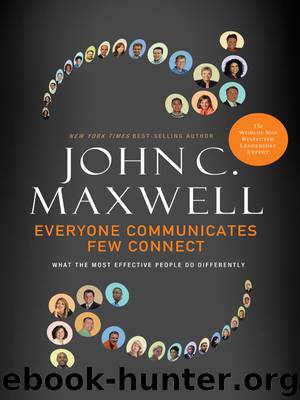Everyone Communicates, Few Connect by John C. Maxwell

Author:John C. Maxwell
Language: eng
Format: epub
Tags: ebook, book
Publisher: Thomas Nelson
Published: 2011-02-20T16:00:00+00:00
CONNECTING WITH PEOPLE AT ALL LEVELS
CONNECTING PRACTICE: Connectors connect on common ground.
KEY CONCEPT: Know the reasons you and your listener want to communicate and build a bridge between those reasons.
CONNECTING ONE-ON-ONE
When two people come together to communicate, each of them has a reason for doing so. To connect on common ground, you must know your reason, know the other person’s reason, and find a way to connect the two. The bottom line in finding common ground is knowing how to make the interaction a win for both parties.
Building a bridge on common ground is easier one-on-one than with many people because you can get immediate and continuous feedback from the other person. To find common ground, ask questions with an eye for common interests and experiences. When you find common ground, tell stories, share emotions, and offer lessons learned from those experiences. And if possible, do something together that you both enjoy.
CONNECTING IN A GROUP
Finding common ground in a group setting is a little more difficult because you can’t focus on just a single person. (If you do, you risk losing the rest of the group.) So how do you do it? Begin by asking yourself, “What brought us together?” The answer to that question usually gives you an effective starting point.
If the group has been forced to come together, such as a mandatory committee designated by an employer, then ask yourself, “What is the one goal that all of us have?” With that goal in mind, acknowledge everyone’s differences but also their ability to contribute to that common goal using their unique skills, reminding them that the goal is more important than the role. And when the group accomplishes a win, celebrate together.
CONNECTING WITH AN AUDIENCE
When people come to hear someone speak, their hope is to learn something that will help them. An anticipating audience has this first and foremost in their minds. A hostile audience may not be thinking about it, but if listening is to their advantage, they will be open to it. Tap into this desire to connect on common ground the next time you communicate in front of an audience. Use the following pattern: Feel, Felt, Found, Find.
• FEEL: Try to sense what they feel and acknowledge and validate their feelings.
• FELT: Share with them that you have also felt the same way.
• FOUND: Share with them what you found that has helped you.
• FIND: Offer to help them find help for their lives.
Download
This site does not store any files on its server. We only index and link to content provided by other sites. Please contact the content providers to delete copyright contents if any and email us, we'll remove relevant links or contents immediately.
Hit Refresh by Satya Nadella(9085)
The Compound Effect by Darren Hardy(8873)
Change Your Questions, Change Your Life by Marilee Adams(7690)
Nudge - Improving Decisions about Health, Wealth, and Happiness by Thaler Sunstein(7660)
The Black Swan by Nassim Nicholas Taleb(7063)
Deep Work by Cal Newport(6970)
Rich Dad Poor Dad by Robert T. Kiyosaki(6517)
Daring Greatly by Brene Brown(6476)
Principles: Life and Work by Ray Dalio(6299)
Playing to Win_ How Strategy Really Works by A.G. Lafley & Roger L. Martin(6090)
Man-made Catastrophes and Risk Information Concealment by Dmitry Chernov & Didier Sornette(5958)
Digital Minimalism by Cal Newport;(5707)
Big Magic: Creative Living Beyond Fear by Elizabeth Gilbert(5681)
The Myth of the Strong Leader by Archie Brown(5461)
The Slight Edge by Jeff Olson(5379)
Discipline Equals Freedom by Jocko Willink(5337)
The Motivation Myth by Jeff Haden(5176)
The Laws of Human Nature by Robert Greene(5087)
Stone's Rules by Roger Stone(5053)
